
Guests
- Antonio Frenchlongtime community advocate in St. Louis, Missouri. He has been in Ferguson live-tweeting and posting Vine videos of protests over the police shooting of Michael Brown.
- Cornell William Brookspresident/CEO of the NAACP and longtime human rights advocate, lawyer and minister.
Protesters in St. Louis, Missouri, are demanding justice in a police shooting that killed an unarmed African-American teen. Eighteen-year-old Michael Brown was shot to death in the suburb of Ferguson on Saturday afternoon. Brown was reportedly walking in the middle of the street with his friend when a police officer drove up and ordered them onto the sidewalk. The St. Louis County Police is claiming Brown physically assaulted the officer and tried to reach for his weapon inside a police car. But witnesses have provided a sharply different account, saying Brown was shot with his arms up as he tried to flee the officer’s fire. Brown had recently graduated from high school and was due to begin college courses this week. Protests began immediately after the shooting, with tensions escalating on Sunday when demonstrators were met by riot police with dogs. We speak to Cornell William Brooks, president and CEO of the NAACP, who is in Ferguson meeting with the local community. We are also joined by Antonio French, a community advocate who has been live-tweeting and posting Vine videos of the protests.
Transcript
AARON MATÉ: We turn now to St. Louis, Missouri, where protesters are demanding justice in a police shooting that killed an unarmed African-American teen. Eighteen-year-old Michael Brown was shot to death in the suburb of Ferguson on Saturday afternoon after he was confronted by police. Witnesses say Brown was walking in the middle of the street with his friend, when a police officer drove up and ordered them onto the sidewalk. Brown’s friend, Dorian Johnson, described what happened.
DORIAN JOHNSON: Me and my friend, we was walking down the street in the middle of the street, and we wasn’t causing any harm to nobody. We had no weapons on us at all. We were just walking, having a conversation. No cars were blowing at us or honking at us like we was holding up traffic or anything like that. And a police officer squad car pulled up. And when he pulled up, these was his exact words: He said, “Get the f— on the sidewalk.” And we told the officer we was not but a minute away from our destination, and we would surely be off the street. We was having a conversation. And he went about his way for about one or two seconds, as we continued to walk, and then he reversed his truck, his car, in a manner to where it almost hit us. It blocked both lanes off, the way he turned his car.
So, he pulled up on the side of us. He tried to thrust his door open, but we were so close to it that it ricocheted off us and it bounced back to him. And I guess that, you know, got him a little upset. At that time, he reached out the window. He didn’t get out the car. He just reached his arm out the window, grabbed my friend around his neck and was trying to—as he was trying to choke my friend. And he was trying to get away, and the officer then reached out, and he grabbed his arm to pull him into the car. So now it’s like the officer is pulling him inside the car. He’s trying to pull away. And at no time the officer said that he was going to do anything, until he pulled out his weapon. His weapon was drawn, and he said, “I’ll shoot you,” or, “I’m going to shoot.” And in the same moment, the first shot went off. And we looked at him. He was shot, and there was blood coming from him. And we took off running.
As we took off running, I ducked and hid for my life, because I was fearing for my life. And I hid by the first car that I saw. My friend, he kept running, and he told me to keep running, because he feared for me, too. So, as he was running, the officer was trying to get out of the car. And once he got out the car, he pursued my friend, but his weapon was drawn. Now, he didn’t see any weapon drawn at him or anything like that, us going for no weapon. His weapon was already drawn when he got out the car. He shot again. And once my friend felt that shot, he turned around, and he put his hands in the air, and he started to get down. But the officer still approached with his weapon drawn, and he fired several more shots. And my friend died. He didn’t say anything to him. He just stood over, and he was shooting. By then, I was so afraid for my life, I just—I got up, and I ran.
AARON MATÉ: That was Dorian Johnson describing how he saw a police officer shoot and kill his friend Michael Brown on Saturday. The St. Louis County Police version of events is sharply different. It claims Brown physically assaulted the officer involved and tried to reach for his weapon inside a police car. This is Police Chief Jon Belmar.
POLICE CHIEF JON BELMAR: Allegedly pushed the police officer back into the car, where he physically assaulted the police officer. It is our understanding at this point in the investigation that within the police car there was a struggle over the officer’s weapon. There was at least one shot fired within the car.
AMY GOODMAN: Michael Brown lived in St. Louis but was in Ferguson visiting his grandmother. He had recently graduated from high school, was due to begin college courses this week. Just last week, he posted a haunting message on Facebook as he prepared to enter new phase in his life, writing, quote, “if i leave this earth today … at least you’ll know i care about others more then I cared about my damn self.”
Protests began immediately after Michael Brown was shot. Police reportedly left his body laying in the street for several hours. Officers said they needed time to process the site and that the crowd that gathered made it hard for them to properly gather evidence.
Tensions escalated Sunday as protesters took to the streets again and were met by riot police with dogs. A CNN reporter caught one officer referring to the demonstrators as “animals.”
GEORGE HOWELL: Racial tensions and nerves on edge. Even an officer we caught on camera gave into his rage, calling protesters “animals.” Listen.
POLICE OFFICER: Bring it! Oh, you [bleep], bring it! [bleep]
AMY GOODMAN: Michael Brown’s parents discussed her son’s killing at a news conference. This is Michael’s father, Michael Brown Sr., and his mom, Lesley McSpadden.
MICHAEL BROWN SR.: He was funny, silly. He’d make you laugh. Any problems that’d be going on or any situation, there wasn’t nothing that he couldn’t solve. He’d bring people back together. He was a good boy. He didn’t deserve none of this. None of it. We need justice for our son. If you have any information, please, please give it to us.
LESLEY McSPADDEN: He didn’t deserve that, y’all. He didn’t deserve none of that.
MICHAEL BROWN SR.: We need the police report, too. We need to know everything. We want everything. We want this done. We’re going to do this right. I don’t want no violence. We don’t want no violence.
LESLEY McSPADDEN: Because Michael wouldn’t want no violence.
MICHAEL BROWN SR.: He wouldn’t have wanted none of that. None of it. None of it. He would want us to do it right. That’s why we’re doing it right. We’re going to do it the right way. But we need justice for our son.
LESLEY McSPADDEN: That’s my firstborn son. Everybody that know me knew how I felt about my son. I just wish I could have been there to help him. Anything. He didn’t deserve that.
AMY GOODMAN: Michael Brown’s mother and father. The family is being represented by Benjamin Crump, the attorney for Trayvon Martin’s family.
Meanwhile, the unidentified officer who shot Brown has been put on administrative leave, and on Monday the Justice Department announced a civil rights investigation. The FBI will continue to monitor the investigation being carried out by the St. Louis County Police Department.
For more, we go directly to St. Louis, where we’re joined by two guests. Antonio French is with us. He’s been in Ferguson live-tweeting and posting Vine videos of protests. His coverage has been widely credited for drawing national attention to the demonstrators’ concerns, as much of the media portrayed them an angry mob. [French] is also a St. Louis alderman, representing the 21st Ward, longtime community advocate.
And we’re joined by Cornell William Brooks, president and CEO of the NAACP. That’s the National Association for the Advancement of Colored People. He has been in Ferguson, Missouri, to support Brown’s family, spoke there Monday night at a community meeting called by the NAACP, where they held a moment of silence in Brown’s memory. There are plans for a national moment of silence this Thursday.
Cornell William Brooks, Antonio French, we welcome you both to Democracy Now! I want to start with Antonio French. Three days of protests have taken place. The Justice Department says they are also going to conduct an investigation. Is it the same investigation? Will they be doing an independent investigation? The family is also calling for a separate autopsy. Tell us the latest.
ANTONIO FRENCH: Well, it’s been described as a parallel investigation being conducted at the same time as the St. Louis County investigation is going on. And I think that’s what’s needed. There is so little trust between the community and the local Ferguson Police Department, and even the St. Louis County Police Department, that people really need an outside view of what’s going on down here in order to be able to make sure that justice is delivered.
AARON MATÉ: Antonio French, I’m looking at some stats here. It says last year black Missourians were 66 percent more likely to be stopped by the police. Can you put this shooting, this killing, in that context?
ANTONIO FRENCH: Well, the context is that there is tension that’s been around for years. This has been growing, and I think this Michael Brown incident is what has caused it to boil over. But the tension between especially young African-American males and the people who police their neighborhoods is something that’s been ongoing. You know, you take an area like Ferguson, which is a majority African-American township, and it has an almost all-white police force, many of them not from the Ferguson community. And it’s created this kind of tension. And over the last few days, as Ferguson has called for backup from neighboring police departments—even the Missouri Highway Patrol has come in—it’s another case of just people coming in that can’t relate directly with the community.
AMY GOODMAN: This is Piaget Crenshaw. She is another eyewitness to the police shooting of Michael Brown.
PIAGET CRENSHAW: I heard gunshots fired, and I’m like, “Oh, my goodness, what’s going on?” I gather all my things and look back out the window. And at this moment, he’s running. He’s chasing after Michael full-forcedly down the street. And gunshots are being fired repeatedly, as well. I went from that window to my balcony, where I then saw Michael. He’s running this way. He turns his body towards this way, hands in the air, being compliant. He gets shot in his face and chest, and goes down and dies.
AMY GOODMAN: That is Piaget Crenshaw. She’s putting up her hands, she’s showing, as he’s putting up his hands in a kind of surrender sign. Cornell William Brooks is president and CEO of the NAACP. What are you calling for now?
CORNELL WILLIAM BROOKS: We’re calling for is not only a full and exhaustive investigation by the Justice Department, but also by the local authorities. This unfortunate, tragic shooting and death occurred in Ferguson, Missouri. Those who are here and on the ground need to assure the community that there will be a full accounting, that this officer will be held accountable. We’re also calling on the community to take action, but take action constructively and nonviolently. We’re here to support them as the National Association for the Advancement of Colored People and to support the folks on the ground who’ve been in this community for years and who represent the community that Michael Brown grew up in.
AARON MATÉ: And I understand that the St. Louis NAACP has met with the local police. Do you know yet if the police have spoken to these witnesses? We’ve played two witnesses now, giving such a divergent account from the police account of what happened.
CORNELL WILLIAM BROOKS: Well, what I’m aware of is that the St. Louis president, Mr. Pruitt, has spoken to these witnesses in conjunction with the Justice Department and that the NAACP is assisting this effort in terms of bringing forward witnesses who have credible testimony and offering a safe space for them to come forward. It’s important that we preserve the integrity of this testimony, that we convey to the community that it is safe to come forward and that what you say, any evidence that you may provide, will be taken seriously. And to the extent that the NAACP represents a trusted vehicle, we are happy to do that under very difficult and sad circumstances.
AMY GOODMAN: This is St. Louis County Police Chief Jon Belmar again, speaking Monday about how police responded to the demonstrations over the weekend.
POLICE CHIEF JON BELMAR: We really felt like that with the emotions running as high as they were, with the shooting the previous day of Mr. Brown, that we didn’t want to add to any of that. So, later in the afternoon, it became very clear that special operations from the county was going to have to deploy. And they in fact did.
AMY GOODMAN: That is the St. Louis County police chief, Jon Belmar. Antonio French, I wanted you to describe more what is happening on the streets and how you, as a St. Louis alderman, one of the youngest, decided to get so deeply involved with this. You are nonstop tweeting, sending six-second videos all through these protests.
ANTONIO FRENCH: Yeah, and so, it really started just hours after Mike Brown was killed, even while his body still laid on the ground. The local newspaper here ran a quick story with a headline that “police shooting leads to mob reaction.” And that offended me, frankly. It was not a mob reaction; it was a justified community reaction, I felt. And knowing how local media sometimes treats these situations—I have a background in journalism—so I grabbed my iPhone and ran down there.
When I arrived, by that time, Mike Brown’s body had laid on the ground for close to four hours. Police had separated citizens and Mike Brown’s mom and family members from the site. She was angry, hysterical in the street. No one from the police department came to offer any information to her about the condition of her son, what had happened to her son, would not let her identify her son’s body. And it became a standoff. So the tone of what’s happened in the last few days was set in the hours following the killing. Police formed a barrier, a human barrier of police officers. There was a standoff between the community. And luckily, we didn’t have any violence that night. People were patient. They were hopeful that the next day at the press conference, which was announced, that there would be some hope of justice being served, that some information would be given to the family.
That did not happen. They were very disappointed with what happened at the press conference, this narrative that does not align with any of the eyewitness accounts of what happened. Also that day, the mother of Michael Brown went on local radio and detailed her interactions with the police department since her son was killed. She described being cursed at, being disrespected, not being included, no information being given. And so, people from all over the community—the ward I represent, St. Louis city, is just a few miles down the road from Ferguson, and the death of this young man has struck a chord, because, like I said, the tensions between the young black community and the police is the same, whether it’s in Ferguson or small municipalities around it or St. Louis city. And so, people have come in support of the family and to air their frustrations at the situation.
AARON MATÉ: Antonio, you were at a community meeting on Monday night. What are the protesters’ demands? And have the police even released the name of the officer yet?
ANTONIO FRENCH: Not yet. So, the protesters delivered four demands. The first was the identity of the man who killed Mike Brown. The second was his immediate firing. As you might know right now, he is on paid administrative leave. The third was something very reasonable, which is that the Ferguson officer handbook be distributed to all Ferguson citizens, so they know what police can and cannot do, the rules by which everybody is playing. I think these are reasonable demands. And the community has come out repeatedly over the last few days and had peaceful demonstrations in front of the police department. Even yesterday, in a peaceful demonstration, the police removed the protesters, even though they were standing lawfully on a public sidewalk. And I think the way that the police have handled this with a heavy hand has made the situation worse.
AMY GOODMAN: I—
ANTONIO FRENCH: I think what we need at this time is to—go ahead.
AMY GOODMAN: We just have 30 seconds, and I wanted to bring Cornell William Brooks back in. You were just in New York meeting with Commissioner Bratton, here where Eric Garner was just killed.
CORNELL WILLIAM BROOKS: Yes.
AMY GOODMAN: We know what happened because there was a video taken. Now, both the young man who took the video, Ramsey Orta, and his wife were arrested by police and said that they’ve been harassed. We haven’t seen this kind of video in St. Louis. Your final comment?
CORNELL WILLIAM BROOKS: Well, one of the things I’ll note here is this seems to be one additional chapter in a larger tragic narrative, that being young people accused of minor offenses, underwhelmingly minor offenses, met with overwhelmingly major uses, excessive uses of force. This is being played out across the country. And what it speaks to is a need to change in policing culture and policing tactics. That is to say, the best way to protect the community is to in fact respect the community.
AMY GOODMAN: We have to leave it there, Cornell William Brooks and Antonio French.

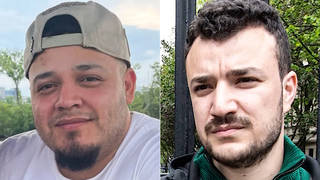

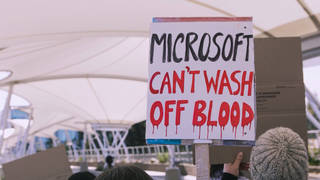
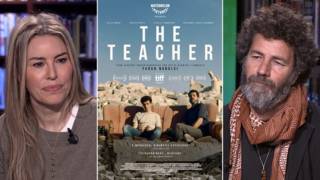





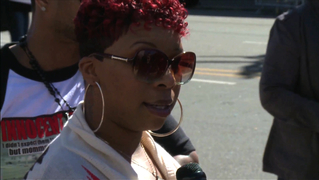
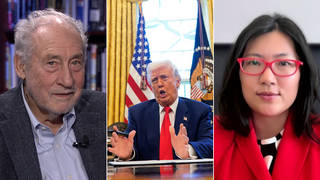
Media Options